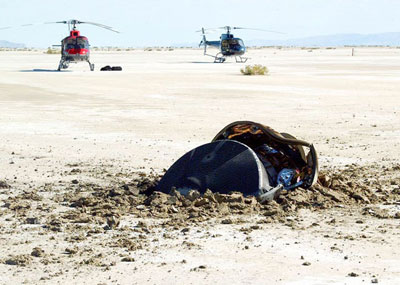“Pit Stop”: a new way to return from spaceby James C. McLane III
|
| The goal is to reduce or eliminate the usual weight penalty and reliability issues associated with parachutes, touchdown cushioning rockets, water flotation devices, and other complex paraphernalia normally required to softly land a space vehicle on the Earth. |
Signals from stationary Global Positioning System (GPS) transmitters on the ground near the landing site, in conjunction with the Orbital GPS system, would help direct the capsule’s final decent. Like a “smart bomb” the vehicle would aim for an exact spot on the earth’s surface. Ground-based vertical wind profilers would provide real-time meteorological updates for the guidance and control system. Other terminal guidance aids, for example LIDAR (light detection and ranging) or active laser tracking might also be used to achieve great accuracy.
In this “Pit Stop” concept, the landing capsule, carefully steered in its plunge to earth, would aim for the opening of a deep vertical shaft set into the ground. The capsule would dive into this hole while still falling at terminal velocity.
The recovery shaft would extend straight down into the earth for hundreds of meters and be closed off and pressure tight at its base. Detailed shaft shape and depth would affect the desired deceleration rate. For recovery of an object that could withstand high G-loads, the shaft might be only a few hundred meters deep. For a low G-load recovery, a shaft over a thousand meters deep would probably be required.
The landing capsule would fit loosely in the entrance of the pit, but clearance would tighten with depth. As the capsule descends, air would flow around the vehicle through the narrowing gap between it and the shaft wall. Appropriate vehicle shaping might encourage it to seek a stable position in the center of the shaft, but it’s also possible it might be pulled toward a wall by aerodynamic effects. Since scraping against the shaft wall is possible, abrasion could be addressed by coating the shaft with a film of water or other material. As the capsule descends, it would act as a piston, compressing the air in front of its direction of travel. It would slow down rapidly because the compressed air would behave like a soft, pneumatic spring.
Eventually the spacecraft would stop. In one scenario, as air escapes around its body, the vehicle would slowly sink down to the bottom of the pit and finally be stopped by a cushioning system. Airlocks at the bottom would open and a human recovery crew would gain access.
As the capsule speeds down the shaft, there is some possibility that the air compressed below might not escape fast enough to give the desired deceleration profile. If so the vehicle could stop and then bounce back upward, propelled by the compressed air, then halt, then descend again to a stop, then rise, then descend, etc., in a sequence of elevator –like up and down moves that slowly dampen out. One way to prevent rebound would be to contour the sides of the spacecraft so that air can vent by (or maybe even through) its body. Another way to avoid a pogo stick affect might be to arrange the primary shaft to nestle concentrically inside a larger outer tube. Vent holes or slots between the two shafts would release air from under the capsule at a controlled rate.
The best site for “Pit Stop” ground stations would be a place with no wind, but light or steady local winds could be compensated for by the vehicle’s terminal guidance. Daily upper atmospheric variables such as density, high altitude winds and irregular de-orbit burn characteristics all introduce uncertainty in the final reentry path. These unknowns could be addressed by installing several “Pit Stop” capture facilities spaced kilometers apart along the reentry ground track in the general landing area. The final choice of which receiving pit to use would be made when the capsule begins its atmospheric dive toward the ground.
The “Pit Stop” recovery scheme should work with a wide range of vehicles. When the system is proven to be reliable, it may be especially attractive for use with manned vehicles that pay a big weight penalty to achieve soft-landing capability. Shaft recovery provides pneumatic cushioning that’s inherently automatic and reliable. The vehicle guidance and control system must be absolutely trustworthy, but the directional precision needed for such control is demonstrated regularly in existing military applications.
| When the system is proven to be reliable, it may be especially attractive for use with manned vehicles that pay a big weight penalty to achieve soft-landing capability. |
Back in 2004 the parachute system failed on a Chinese reentry vehicle, yet the capsule remained basically intact after smashing through the roof of a house. In the same year, when the chutes on NASA’s Genesis capsule malfunctioned, that deep space probe hit the Utah desert traveling at almost 100 meters per second. Relatively soft soil kept the capsule from disintegrating and much of the payload was recovered. These two rare accidents show that it is possible for a spacecraft to survive after falling through the lower atmosphere with no retarding devices and striking the ground.
Thus, a totally successful soft landing is mostly a matter of controlling the final deceleration. It makes perfect sense to put equipment on the ground to do this rather than to carry heavy landing devices on the vehicle. An underground recovery system based on this “Pit Stop” concept could become routine when it’s appreciated that such a scheme would be simple, safe, and economical.
